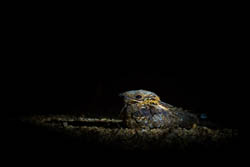Many animals avoid roads due to traffic disturbance, but there are also some species that use roads in their everyday life and even obtain resources from them. Understanding the factors that influence the intensity of road use by these species can help understand temporal patterns of road mortality and thereby maximize the cost-effectiveness of mitigation measures. This study, conducted between 2009 and 2017 in Doñana, investigates the environmental factors influencing road use in the red-necked nightjar Caprimulgus ruficollis, a nocturnal insectivorous bird that frequents roads to forage and thermoregulate. Nightjar abundance on roads was affected by ambient temperature, amount of moonlight, and wind conditions, all factors known to influence their foraging efficiency and thermoregulatory requirements. Specifically, the highest numbers of nightjars on roads occurred during no-wind conditions and on either dark-cold or bright-warm nights, suggesting that they preferentially use roads (i) for thermoregulation under unfavourable weather conditions or (ii) to maximize food intake during periods of increased insect abundance (warm nights) and improved conditions for visual prey detection (full moon). These results illustrate the role of environmental conditions as drivers of rapid changes in the use of roads by animals and suggest that analogous studies can be used to inform mitigation measures, so that mitigation efforts to prevent roadkills can be concentrated during periods of expected peaks in animal use of roads. informacion[at]ebd.csic.es: De Felipe et al. (2019) Environmental factors influencing road use in a nocturnal insectivorous bird. Eur J Wildl Res https://doi.org/10.1007/s10344-019-1267-5
https://link.springer.com/article/10.1007/s10344-019-1267-5

 Las altas temperaturas están provocando que las lagunas y las marismas de Doñana pierdan agua rápidamente
Las altas temperaturas están provocando que las lagunas y las marismas de Doñana pierdan agua rápidamente




